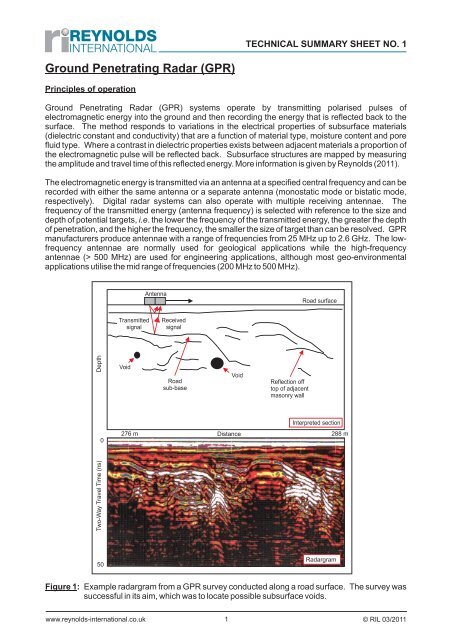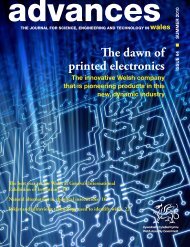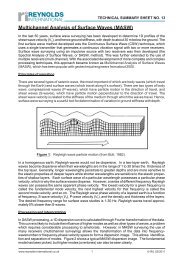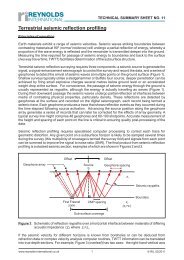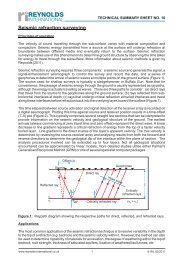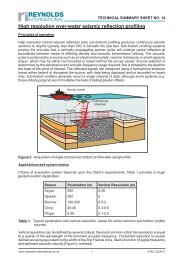Ground Penetrating Radar (GPR) - Reynolds International Ltd
Ground Penetrating Radar (GPR) - Reynolds International Ltd
Ground Penetrating Radar (GPR) - Reynolds International Ltd
Create successful ePaper yourself
Turn your PDF publications into a flip-book with our unique Google optimized e-Paper software.
TECHNICAL SUMMARY SHEET NO. 1<strong>Ground</strong> <strong>Penetrating</strong> <strong>Radar</strong> (<strong>GPR</strong>)Principles of operation<strong>Ground</strong> <strong>Penetrating</strong> <strong>Radar</strong> (<strong>GPR</strong>) systems operate by transmitting polarised pulses ofelectromagnetic energy into the ground and then recording the energy that is reflected back to thesurface. The method responds to variations in the electrical properties of subsurface materials(dielectric constant and conductivity) that are a function of material type, moisture content and porefluid type. Where a contrast in dielectric properties exists between adjacent materials a proportion ofthe electromagnetic pulse will be reflected back. Subsurface structures are mapped by measuringthe amplitude and travel time of this reflected energy. More information is given by <strong>Reynolds</strong> (2011).The electromagnetic energy is transmitted via an antenna at a specified central frequency and can berecorded with either the same antenna or a separate antenna (monostatic mode or bistatic mode,respectively). Digital radar systems can also operate with multiple receiving antennae. Thefrequency of the transmitted energy (antenna frequency) is selected with reference to the size anddepth of potential targets, i.e. the lower the frequency of the transmitted energy, the greater the depthof penetration, and the higher the frequency, the smaller the size of target than can be resolved. <strong>GPR</strong>manufacturers produce antennae with a range of frequencies from 25 MHz up to 2.6 GHz. The lowfrequencyantennae are normally used for geological applications while the high-frequencyantennae (> 500 MHz) are used for engineering applications, although most geo-environmentalapplications utilise the mid range of frequencies (200 MHz to 500 MHz).AntennaRoad surfaceTransmittedsignalReceivedsignalDepthVoidRoadsub-baseVoidReflection offtop of adjacentmasonry wallInterpreted section0276 mDistance288 mTwo-Way Travel Time (ns)50<strong>Radar</strong>gramFigure 1: Example radargram from a <strong>GPR</strong> survey conducted along a road surface.successful in its aim, which was to locate possible subsurface voids.The survey waswww.reynolds-international.co.uk 1© RIL 03/2011
The output of a <strong>GPR</strong> survey is a series of radargrams, analogous to a seismic section, which is arecord of the reflected energy displayed in terms of Two-Way Travel Time (TWTT) versus horizontaldistance. Two-Way Travel Time is the time taken for the energy to travel from the transmittingantenna to the subsurface reflector and back up to the surface. <strong>Radar</strong> waves travel at the speed oflight (0.2998 m/ns) through air, but their propagation velocity through engineering and geologicalmaterials is much slower (c. 0.05-0.14 m/ns). Disruption of reflections from known linear featuresoften indicates anomalous volumes of material (e.g. voids) in the overburden. Usually, radargramscan be interpreted immediately after limited data processing (e.g. filtering and gain application) but,in cases that justify the additional expense of advanced, complex processing, <strong>GPR</strong> data can beanalysed to highlight features that might otherwise remain undetected.Applications· Geological and hydrogeological investigations including mapping of bedrock topography,water levels, solution features, glacial structures, soils and aggregates.· Engineering investigations to evaluate dams, sea walls, tunnels, pavements, road beds,railway embankments, piles, bridge decks, river scour, buildings and monuments.· Location and evaluation of buried structures including utilities, foundations, reinforcing bars,cavities, tombs, archaeological artefacts, and animal burrows.· Brownfield site investigations: location of buried engineering structures and undergroundstorage tanks.Advantages· Rapid ground coverage afforded by towing the antennae either by hand or from a vehicle.· High lateral resolution of targets, even for larger surveys.· The instant graphic display offered by most <strong>GPR</strong> systems allows on-site interpretation.LimitationsTECHNICAL SUMMARY SHEET NO. 1· Data acquisition may be slow over difficult terrain.· Depth of penetration is limited in materials with high electrical conductivities, e.g. clays.· Energy may be reflected and recorded from above-ground features, e.g. walls, canopies, etc.unless antennae are well shielded.· Artefacts in the near surface (e.g. reinforcing bars, boulders, components of made ground,etc.) may scatter the transmitted energy and complicate the received signal and/or reducedepth of penetration.200 mmBase of concrete slabCobbleSoilPeatSand and gravelDepth (m) 0Bottom of sub-baseSteel cage inroad constructionSteel dowel20 mm diameterSand and gravel0 5 m4Figure 2:Left: Migrated 1.5 GHz radargram revealing steel dowels in concrete. Right: unmigrated100 MHz radargram showing shallow sedimentary deposits in a peat bog.Reference<strong>Reynolds</strong>, J.M. 2011. An Introduction to Applied and Environmental Geophysics. John Wiley & S o n s<strong>Ltd</strong>, Chichester, 2nd ed., 712 pp.www.reynolds-international.co.uk 2© RIL 03/2011


